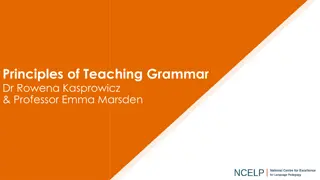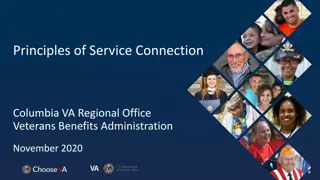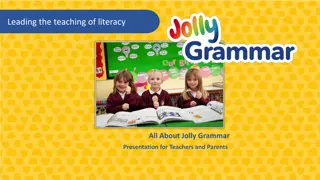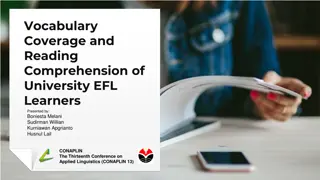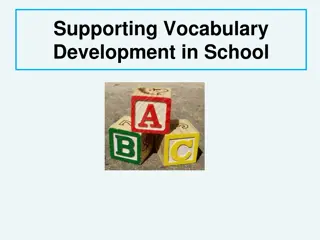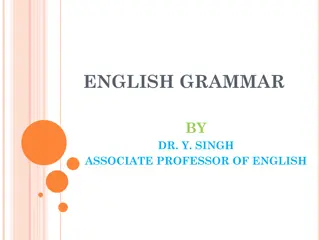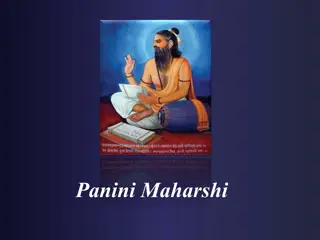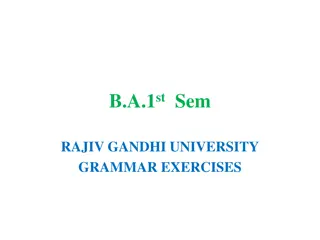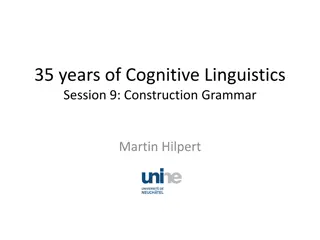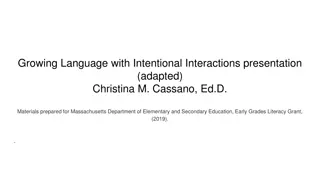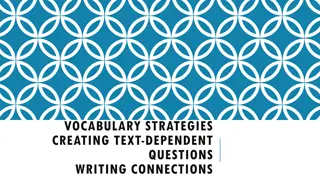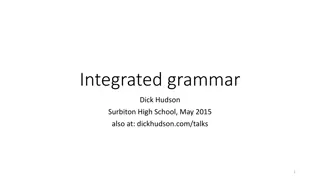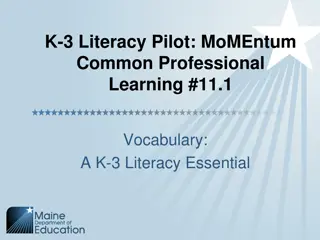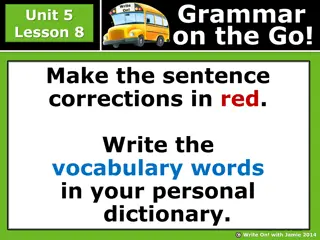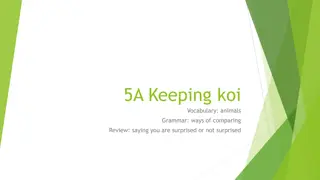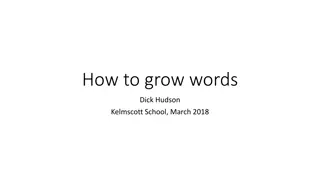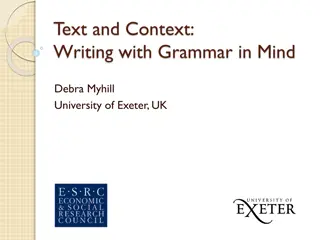Exploring Vocabulary and Grammar Connection
Discover the interconnectedness of grammar and vocabulary through engaging activities and insights from experts. Explore high-frequency words, categorize words, and practice vocabulary strategies in fun ways. Engage in activities like strange dictation, taboo, and mixing adjectives with nouns to enhance language skills effectively.
Download Presentation

Please find below an Image/Link to download the presentation.
The content on the website is provided AS IS for your information and personal use only. It may not be sold, licensed, or shared on other websites without obtaining consent from the author. Download presentation by click this link. If you encounter any issues during the download, it is possible that the publisher has removed the file from their server.
E N D
Presentation Transcript
Shadow words: Connecting grammar and vocabulary Alice Savage & Colin Ward Lone Star College North Harris
Words Content Grammar Shadow fork store smell traffic for the be since place important bring achieve Vocabulary selected from Trio Writing Oxford University Press (in press)
The dynamic nature of words Words are not isolated units of language, but fit into many interlocking systems. - Paul Nation
Which category is each word? Content Grammar Shadow 1. approach 2. hill 3. however 4. atmosphere 5. natural 6. sky 7. realize 8. towards
Vocabulary strategies Sensory Cues Joshua Foer Multiple hits Paul Nation Brief encounters Keith Folse i + one Stephen Krashen Clusters and chunks Norbert Schmidt/Eli Hinkle Reiteration Diane Larsen-Freeman
Practice Activity 1: Strange Dictation Student Put your pen/pencil in your left hand (or right hand if you are left handed) Write the words you hear. Teacher Say the target words once. Say it in a sentence. Repeat the words. Repeat Use your regular hand, but write the words backwards.
Practice Activity 2: Taboo Partner A: Partner B: Face the screen. Look at the phrases and pictures. Say anything you can to help your partner guess the phrase, but do not say it. Face your partner with your back to the screen. Listen to your partner, and guess the phrase.
Practice Activity 3: Mix & Match Adjectives Nouns Students: Get in pairs. Match words and make phrases. Make, ask and answer questions. popular stadiums dangerous gamers local sports talented athletes 1. Where? 2. What? 3. Why? professional competitions
Practice Activity 4: Word Forms Partner A: Partner B: Look at phrase A. Create a sentence that describes the picture. Look at phrase B. Create a sentence that describes the picture.
Practice activity 5: Flow Charts Questions 1. What is your favorite sentence? 2. What does the sentence mean? 3. What are some examples? Students: Write two sentences. Share your sentences. Discuss the meaning.
Practice activity 6: Assists Add nouns or noun phrases to write simple introductory sentences. 1. My son pointedat 2. He was amazedby the 3. In the distance, there were 4. We looked up and noticeda 5. He had never experienced
Practice Activity 7: online 3-2-1 Students: Use your device. Go to www.just-the-word.com Look up the target words. Write: 3 phrases. 2 sentences. 1 question. Share your phrases and sentences. Ask your partner the question. Answer your partner s question. Student A ordinary Student B join
Other activity types Pictionary Hangman Charades Concentration Word chains Round robin With a phone?
Contact Info & Website Visit our website and blog! englishendeavors.org Contact us: alice.o.savage@lonestar.edu colin.s.ward@lonestar.edu
References Clay, B., Blythe, R., Bybee, J., Christiansen, M., Croft, W., Ellis, N., Holland, J., Ke, J., Larson-Freeman, D., Shoenemann, T. (2009). Language is a complex adaptive System: Position Paper. Language Learning 59 (pp. 1-26). Michigan: University of Michigan. Ellis, R. (1997). Vocabulary acquisition: word structure, collocation, word-class, and meaning. In N. Schmitt & M. McCarthy (Eds.), Vocabulary: Description, acquisition, and pedagogy (pp. 122-139). Cambridge: Cambridge University Press. Foer, J (2011). Moonwalking with Einstein: The Art and Science of Remembering Everything. New York, NY: The Penguin Press Granger, S. (1998). Prefabricated patterns in advanced EFL writing: collocations and lexical phrases. In A. Cowie (Ed.), Phraseology: theory, analysis and applications (pp. 145-160). Oxford: Oxford University Press. Hinkel, E. (2012). Innovative and Efficient Construction Grammar. Selected papers from the 21st International Symposium on English Teaching.English Teacher s Association, Republic of China (ETA-ROC), Taipei, 51-59. Hinkel, E. (2011) What research on second language writing tells us and what it doesn t. In E. Hinkel (Ed.), Handbook of research in Second Language Teaching and Learning, Volume 2 (pp. 523-538). New York: Routledge.
References Hinkel, E. (2004) Teaching academic ESL writing: Practical techniques in vocabulary and grammar. Mahwah, NJ: Lawrence Erlbaum. Krashen, S. (1981). Second Language Acquisition and Second Language Theory. London: Pergamon Press Inc Larsen-Freeman, D. (1997). Chaos/complexity science and second acquisition. Applied Linguistics, 18, 141-165. Nation, I.S.P. (2001). Learning vocabulary in another language. Cambridge: Cambridge University Press. Schmitt, N. (2000). Lexical chunks. ELT Journal, Volume 54 (4). Oxford: University Press. Learning language Oxford



